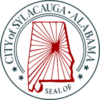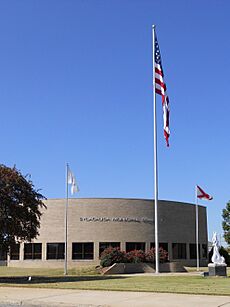Sylacauga, Alabama facts for kids
Quick facts for kids
Sylacauga, Alabama
|
|||
|---|---|---|---|
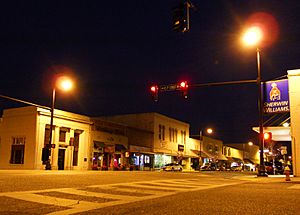
Downtown Sylacauga by night
|
|||
|
|||
Nicknames:
|
|||

Location of Sylacauga in Talladega County, Alabama
|
|||
| Country | United States | ||
| State | Alabama | ||
| County | Talladega | ||
| Area | |||
| • Total | 20.42 sq mi (52.88 km2) | ||
| • Land | 20.25 sq mi (52.46 km2) | ||
| • Water | 0.16 sq mi (0.42 km2) | ||
| Elevation | 545 ft (166 m) | ||
| Population
(2020)
|
|||
| • Total | 12,578 | ||
| • Density | 621.01/sq mi (239.78/km2) | ||
| Time zone | UTC-6 (Central (CST)) | ||
| • Summer (DST) | UTC-5 (CDT) | ||
| ZIP codes |
35150-35151
|
||
| Area code(s) | 256/938 | ||
| FIPS code | 01-74352 | ||
| GNIS feature ID | 0160702 | ||
Sylacauga is a city in Talladega County, Alabama, United States. In 2020, about 12,578 people lived there.
Sylacauga is famous for its beautiful white marble. This special rock was found soon after people settled in the area. It has been dug up and used ever since. The marble business was the first big industry in Sylacauga.
This city is also known for a very rare event. On November 30, 1954, a piece of the Sylacauga Meteorite hit a person. A 4-kilogram (about 9-pound) piece crashed through a house roof. It bounced off a radio and bruised Ann Hodges, who was taking a nap. This was the first time a space object was officially recorded hitting a person.
In 2010, Sylacauga was named one of the "100 Best Communities for Young People." This award came from America's Promise Alliance.
Contents
History of Sylacauga
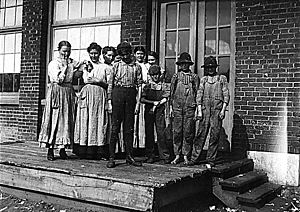
The first stories about this area come from 1540. An explorer named de Soto traveled along the Coosa River. He found a town called Talisi. This town was on the edge of two large Native American chiefdoms, Coosa and Tuskaloosa.
Later, the people living in the Coosa River Valley joined together. They formed the Creek people confederacy. Spanish and French settlers also came to the area. Their interactions with the Native Americans greatly shaped Sylacauga's history.
In 1748, a village called Chalakagay was settled near modern Sylacauga. Shawnee Indians, led by Peter Chartier, moved there. French records from 1759 show Chalakagay had 50 Shawnee warriors. In 1836, most Native Americans in Alabama were forced to move west. This was due to the Indian Removal Act. They had to give up their land for European American settlers.
The name Sylacauga might come from the Indian words Chalaka-ge. This means "The Place of the Chalaka Tribe." Other ideas suggest it comes from Creek words "suli" (buzzards) and "kagi" (roost). The city was first officially recognized in 1838 as Syllacoga. It was recognized again in 1887 as Sylacauga.
By the 1830s, important roads crossed the region. Ferries helped people cross rivers. In 1852, a special plank road was built. It went from Montgomery, the capital, through Sylacauga. The first train track arrived on December 1, 1886. The first post office opened in 1838. George Washington Stone was the first postmaster. He later became a top judge in Alabama.
The first newspaper, the Sylacauga Argus, started in 1887. Broadway Avenue is Sylacauga's main street. The first building there was built in 1890.
Sylacauga is known as "The Marble City." It sits on a huge amount of marble. Many believe this is the best marble in the world. Famous buildings like the United States Supreme Court and the Al Jolson Shrine in California use Sylacauga marble.
Sylacauga is a bit east of the center of Alabama. It is in Talladega County. The city is about 51 miles (82 km) southeast of Birmingham. It is 63 miles (101 km) north of Montgomery. It is also 40 miles (64 km) southwest of Anniston.
The Marble Industry
The first time marble was officially found was in 1820. Dr. Edward Gantt, a doctor, made the discovery. He had been with General Andrew Jackson in the area. This marble deposit is part of the "Murphy Marble Belt." It is 32 miles (51 km) long and 1.5 miles (2.4 km) wide. It is also 400 feet (122 meters) deep. It is the world's largest deposit of a type of marble called madre cream.
In the 1830s, several marble quarries opened. Quarries are places where stone is dug up. Operators used the old Plank Road to ship marble around central Alabama. By 1906, companies from New York bought Gantt's quarry. This became a main place for marble work. A special town grew around this area, later called the Alabama Marble Company.
By the early 1900s, Sylacauga marble was well-known. It was shipped all over the state. Besides building materials, marble was also used in the steel industry. More and more Sylacauga marble was used to help make steel. Later, a rock called dolomite took its place. Even with the Great Depression coming, the marble industry grew a lot in the late 1920s and early 1930s.
New technology changed the industry. Electricity replaced steam power. Many small marble businesses closed or were bought by bigger companies. Two main companies were Alabama and Moretti-Harrah. In 1929, Madras Marble Company joined with Moretti-Harrah.
In 1935, Moretti-Harrah Company was sold. In 1944, B.F. Coggins sold the Sylacauga business to T.A. McGahey. The Alabama Marble Company stayed independent until 1963. Then, it joined with the Georgia Marble Company.
Sylacauga marble was used in many important buildings across the country. The Alabama Marble Company supplied marble for the Washington Monument and Lincoln Memorial. The marble for the Washington Monument looked so much like Italian Carrara marble that it was set aside until its origin was confirmed. Moretti-Harrah provided much of the marble for the U.S. Supreme Court building. This included 36 huge columns inside.
Many other famous places use this shiny stone. These include the Dime Savings Bank in New York and the Chicago Post Office. Cream marble from Sylacauga can be found in hotels, offices, and homes everywhere.
The famous sculptor Gutzon Borglum used Alabama marble. He created the Mount Rushmore National Memorial. He also sculpted a bust of Abraham Lincoln from Alabama marble. It is in the U.S. Capitol. Borglum said the fine texture of Alabama marble helped him show Lincoln's kind expression. He could not do this with other stones.
By the 1940s, people found endless uses for products from marble. Calcium from marble was needed for farming, medicines, and paint. The Alabama Marble Company started making these products in 1933. They sold them as Alabama Calcium Products. By 1964, the company had one of the largest calcium carbonate plants in the U.S. In 1967, they stopped making structural marble.
Moretti-Harrah kept making finished marble products. They used new machines to make tiles and window sills. They also started making calcium products. In 1944, they partnered with Thompson-Weinman and Company. Thompson-Weinman expanded its own crushing operations in Sylacauga in 1956. Sylacauga Calcium Products became part of Moretti-Harrah.
Thompson, Weinman and Company was bought by Cyprus Mines Corporation in 1975. Then, Standard Oil Company bought Cyprus Mines in 1979. In 1983, they expanded their calcium carbonate facilities. Calcium carbonate became important for paper making. In 1988, English China Clays (ECC) International bought Moretti Harrah. In 1989, ECC bought Cyprus Thompson Weinman. Then, Georgia Marble Company bought Cyprus Thompson Weinman.
In 1995, Imetal Group from Paris bought the Georgia Marble Company. This helped them grow in the U.S. white pigments industry. By 1999, Imetal bought ECC. The company changed its name to Imerys. This new name showed their focus on processing minerals.
Geography and Climate
Location of Sylacauga
The city is in the southern part of Talladega County. Major roads that go through Sylacauga include US Routes 280 and 231. Also, Alabama State Route 21 passes through. US 280 goes northwest to southeast. It leads northwest 10 miles (16 km) to Childersburg. It also goes 47 miles (76 km) to Birmingham. US 280 goes southeast 26 miles (42 km) to Alexander City. US 231 goes south 21 miles (34 km) to Rockford. Alabama 21 goes northeast 21 miles (34 km) to Talladega.
Sylacauga's Climate
The weather here has hot, humid summers. Winters are usually mild to cool. Sylacauga has a humid subtropical climate. This means it gets a lot of rain and has warm temperatures most of the year.
| Climate data for Sylacauga, Alabama (1991–2020 normals, extremes 1955–present) | |||||||||||||
|---|---|---|---|---|---|---|---|---|---|---|---|---|---|
| Month | Jan | Feb | Mar | Apr | May | Jun | Jul | Aug | Sep | Oct | Nov | Dec | Year |
| Record high °F (°C) | 81 (27) |
83 (28) |
90 (32) |
91 (33) |
99 (37) |
101 (38) |
102 (39) |
104 (40) |
99 (37) |
99 (37) |
88 (31) |
80 (27) |
104 (40) |
| Mean daily maximum °F (°C) | 54.5 (12.5) |
58.7 (14.8) |
66.7 (19.3) |
74.6 (23.7) |
81.3 (27.4) |
87.3 (30.7) |
90.3 (32.4) |
89.4 (31.9) |
85.0 (29.4) |
75.6 (24.2) |
65.0 (18.3) |
56.8 (13.8) |
73.8 (23.2) |
| Daily mean °F (°C) | 42.9 (6.1) |
46.5 (8.1) |
54.0 (12.2) |
61.0 (16.1) |
69.1 (20.6) |
76.2 (24.6) |
79.4 (26.3) |
78.4 (25.8) |
73.2 (22.9) |
62.2 (16.8) |
51.7 (10.9) |
45.3 (7.4) |
61.7 (16.5) |
| Mean daily minimum °F (°C) | 31.4 (−0.3) |
34.4 (1.3) |
41.3 (5.2) |
47.5 (8.6) |
56.9 (13.8) |
65.1 (18.4) |
68.5 (20.3) |
67.4 (19.7) |
61.4 (16.3) |
48.8 (9.3) |
38.5 (3.6) |
33.8 (1.0) |
49.6 (9.8) |
| Record low °F (°C) | −4 (−20) |
4 (−16) |
10 (−12) |
21 (−6) |
33 (1) |
39 (4) |
50 (10) |
45 (7) |
32 (0) |
21 (−6) |
14 (−10) |
3 (−16) |
−4 (−20) |
| Average precipitation inches (mm) | 5.55 (141) |
5.88 (149) |
5.45 (138) |
4.79 (122) |
4.40 (112) |
4.97 (126) |
4.62 (117) |
4.32 (110) |
3.70 (94) |
3.46 (88) |
4.71 (120) |
5.25 (133) |
57.10 (1,450) |
| Average snowfall inches (cm) | 0.4 (1.0) |
0.1 (0.25) |
1.2 (3.0) |
0.0 (0.0) |
0.0 (0.0) |
0.0 (0.0) |
0.0 (0.0) |
0.0 (0.0) |
0.0 (0.0) |
0.0 (0.0) |
0.0 (0.0) |
0.0 (0.0) |
1.7 (4.3) |
| Average precipitation days (≥ 0.01 in) | 9.8 | 9.7 | 9.5 | 8.2 | 8.8 | 10.3 | 10.6 | 9.4 | 6.8 | 6.2 | 7.2 | 10.0 | 106.5 |
| Average snowy days (≥ 0.1 in) | 0.2 | 0.1 | 0.1 | 0.0 | 0.0 | 0.0 | 0.0 | 0.0 | 0.0 | 0.0 | 0.0 | 0.0 | 0.4 |
| Source: NOAA | |||||||||||||
People of Sylacauga
| Historical population | |||
|---|---|---|---|
| Census | Pop. | %± | |
| 1890 | 464 | — | |
| 1900 | 880 | 89.7% | |
| 1910 | 1,456 | 65.5% | |
| 1920 | 2,141 | 47.0% | |
| 1930 | 4,115 | 92.2% | |
| 1940 | 6,269 | 52.3% | |
| 1950 | 9,606 | 53.2% | |
| 1960 | 12,857 | 33.8% | |
| 1970 | 12,255 | −4.7% | |
| 1980 | 12,708 | 3.7% | |
| 1990 | 12,520 | −1.5% | |
| 2000 | 12,616 | 0.8% | |
| 2010 | 12,749 | 1.1% | |
| 2020 | 12,578 | −1.3% | |
| U.S. Decennial Census | |||
2020 Census Information
| Race | Num. | Perc. |
|---|---|---|
| White (non-Hispanic) | 7,457 | 59.29% |
| Black or African American (non-Hispanic) | 4,311 | 34.27% |
| Native American | 32 | 0.25% |
| Asian | 69 | 0.55% |
| Pacific Islander | 4 | 0.03% |
| Other/Mixed | 425 | 3.38% |
| Hispanic or Latino | 280 | 2.23% |
In 2020, Sylacauga had 12,578 people. There were 4,943 households and 2,993 families living in the city.
2010 Census Information
In 2010, there were 12,749 people in Sylacauga. There were 5,215 households and 3,419 families. The city had about 681 people per square mile (263 per km²).
The people living in Sylacauga were mostly White (69.17%) and Black or African American (28.91%). A small number were Native American, Asian, Pacific Islander, or from other races. About 0.97% of the people were Hispanic or Latino.
In the city, 25% of the people were under 18 years old. About 18.6% were 65 or older. The average age was 39 years. For every 100 females, there were about 81 males.
The average income for a household was $29,533. For a family, it was $40,275. About 21.3% of the people lived below the poverty line. This included 33.6% of those under 18.
Economy and Jobs
Sylacauga has many different types of jobs. The main jobs are in manufacturing, education, healthcare, and retail.
Here are some of the job areas:
- Manufacturing (making things): 24.2%
- Education, healthcare, and social help: 20.2%
- Retail trade (stores): 12.0%
- Arts, entertainment, recreation, hotels, and food services: 7.2%
- Finance, insurance, and real estate: 6.3%
- Construction (building things): 6.1%
- Transportation, storage, and utilities: 5.2%
- Other services (not government): 5.2%
- Professional, science, and management services: 4.9%
- Public administration (government jobs): 3.3%
- Farming, forestry, fishing, and mining: 2.1%
- Wholesale trade (selling to businesses): 1.6%
- Information (like media and tech): 1.6%
Major companies that employ people in Sylacauga include Blue Bell Creameries, IMERYS, Nemak Alabama, and Wal-Mart. Over 140 manufacturing companies get workers from the Sylacauga area.
Fun Things to Do and See
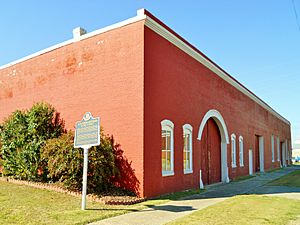
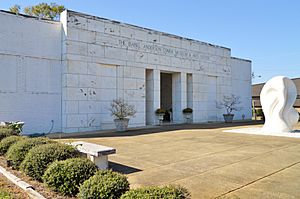
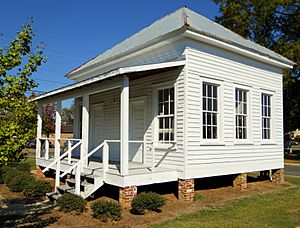
The Sylacauga Public Library started in 1936. It moved into a new building in 1939. This building was built by the Works Progress Administration (WPA). The library was renamed after B. B. Comer, a local factory owner and former governor. The current library building was built in 1979. It was updated in 2003 to add meeting rooms. The B. B. Comer Memorial Library Foundation helps support education. It has won a national award for library service. The library's "Brown Bag" lunch series is popular. It often has over 100 people attending.
The Isabel Anderson Comer Museum and Arts Center opened in 1985. It is in the old city library building. The museum shows the history of Sylacauga marble. It also has art by famous sculptors like Giuseppe Moretti and Geneva Mercer. The museum's Native Sons Gallery honors important people from the area. These include U.S. congressman William Flynt Nichols and actor Jim Nabors.
In 2009, Sylacauga held its first marble festival. This was part of a cultural exchange with Pietrasanta in Italy. The community liked it so much that it became an annual event.
Sylacauga also has many outdoor activities. Noble Park has a skate park, playground, and picnic areas. There is also a quarter-mile walking track. The city pool can be used indoors in winter. Lake Howard is great for boating and fishing. There are also several neighborhood parks. The Sylaward Trail is a 15-mile (24 km) path for hiking and biking. It goes through the Talladega National Forest. Sylacauga also has two golf courses.
Education in Sylacauga
The Sylacauga City Schools system is run by a five-member board. These members are chosen by the City Council. They set the rules for the schools. A Superintendent of Schools manages the daily operations. The school system also follows rules from the State Board of Education. Sylacauga City Schools has been approved by the Southern Association of Colleges and Schools (SACS) for many years.
Sylacauga High School (SHS) was first approved in 1947. Nichols-Lawson Middle School (then East Highland) was approved in 1954. Indian Valley and Pinecrest Elementary schools were approved in 1973. As of 2022, there are 2,024 students in the schools. Almost half of them ride buses. The school system employs 273 people.
Today, there are four schools in the Sylacauga City school system:
- Indian Valley Elementary: Teaches grades K-2.
- Pinecrest Elementary: Teaches grades 3-5.
- Nichols-Lawson Middle: Teaches grades 6-8.
- Sylacauga High: Teaches grades 9-12.
Transportation
Sylacauga is on State Highway 21. This road connects to U.S. Highways 280 and 231. Three major railroads serve the city: Norfolk Southern, CSX, and the Eastern Alabama Railway. There are also eight major trucking companies. Some of them have local offices. Lee Merkle Field is the local airport. The city also has public buses for transportation.
Sylacauga Municipal Airport
Sylacauga Municipal Airport (SCD) is owned by the city. It is west of downtown Sylacauga. It is the closest airport for travel to southeast Birmingham and north Shelby County. The airport has a 5,400-foot (1,646 m) runway.
Notable People from Sylacauga
- Jerry Carl: A U.S. Representative for Alabama.
- Peter Chartier: A Shawnee chief who settled near Sylacauga in 1748.
- Drama: A rapper.
- Mickell Gladness: A professional basketball player.
- T. J. Green: An NFL football player.
- Jon Hand: A football player for the University of Alabama and the Indianapolis Colts.
- Ann Elizabeth Fowler Hodges: The first person officially hit by a meteorite.
- Polly Holliday: An actress.
- Dameian Jeffries: An NFL football player.
- Marcus Knight: An NFL football player.
- Cecil Leonard: A football player.
- Jim Nabors: A famous actor and singer from Gomer Pyle, U.S.M.C..
- William Flynt Nichols: A former U.S. congressman.
- Anthony Parker: An NFL football player.
- Van Allen Plexico: A writer.
- Ricky Porter: An NFL football player.
- F. Richard Spencer: A Roman Catholic bishop.
- James M. Sprayberry: Received the Medal of Honor for his actions in the Vietnam War.
- Billy Todd: A bass singer for the Florida Boys gospel group.
- Gerald Wallace: An NBA basketball player.
- Ehren Wassermann: An MLB player.
- Zelous Wheeler: A baseball player.
See also
 In Spanish: Sylacauga (Alabama) para niños
In Spanish: Sylacauga (Alabama) para niños



